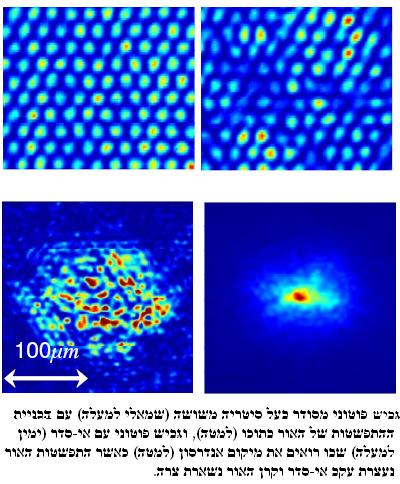Doctoral students Tal Schwartz and Guy Bartel, their supervisor, Professor Moti Segev and Professor Shmuel Fishman from the Faculty of Physics, prove Anderson's theory in a photonic crystal

The Technion researchers were able to show for the first time how a photonic crystal turns from a "conductor" to an "insulator" as a result of the creation of disorder within it. The idea was first proposed in 1958 by Professor Philip Anderson, who even received a Nobel Prize for it. He showed theoretically that when the disorder in a crystalline material is increased - the electrons "get stuck" in place and the crystal turns from a conductor to an insulator. The theory was named "Anderson Localization".
Since then, many researchers around the world have tried to experimentally prove Anderson's theory in a crystalline material, but without success, among other things because Anderson's theory does not take into account additional effects that exist in solids. However, since Anderson's position is based on the wave nature of electrons, it can be expected that similar processes will also occur with light waves. Now the Technion researchers, doctoral students Tal Schwartz and Guy Bartel, their supervisor, Professor Moti Segev and Professor Shmuel Fishman from the Faculty of Physics, have succeeded in proving Anderson's theory in a photonic crystal. Their research is published in the latest issue of the prestigious journal "Nature".
Professor Segev explains: "The atoms of the crystal constitute a kind of 'potential pit' for the electrons, and disorder means a change in the depth of the 'pit'. We experimentally demonstrated for the first time the 'Anderson position' in photonic crystals, in which light sees the photonic crystal as electrons in matter see the periodic structure of atoms. In atomic crystals it is indeed, apparently, impossible to see the 'Anderson position', but we proved for the first time that in photonic crystals this is indeed possible, and we showed that the propagation of light stops due to disorder. However, the ideas we demonstrated are universal and relevant to a variety of undulating phenomena in nature."
"Anderson location" is the transition of the material from a conducting crystal to an insulating crystal, as a result of an increase in disorder within it.
A photonic crystal is a system in which the refractive index of light changes cyclically, that is: the speed of light changes cyclically in the material.

4 תגובות
The bass
Sahtain Guy
What about the bam?
Well done! Even small things can be openings for big things
Sounds interesting and promising, even though I don't understand anything in physics. Turning a conductor into an insulator and vice versa is an ability that has many uses. I wonder if there are already ideas on how to make practical use of the practical demonstration of Philip Anderson's theory